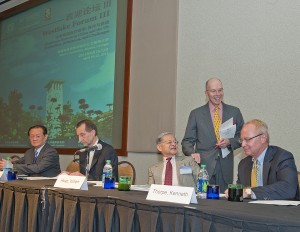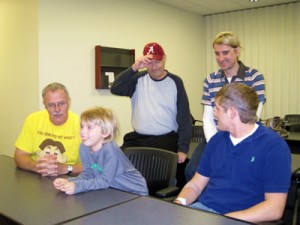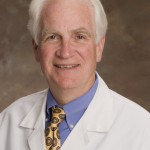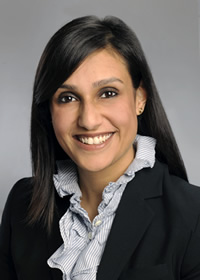The recent Westlake Forum III at Emory brought more than 250 leaders from Chinese and U.S. academic and government institutions together to examine and compare health care reform in the two countries, focusing on cost, quality, and access to care.
“This was an incredible human partnership, bringing together two countries with very different governments and cultures, recognizing our common problems and desires for improved health of all our citizens, working together on difficult issues and exploring workable solutions,” said Jeff Koplan, director of the Emory Global Health Institute.
The third Westlake Forum was the first to be held in the United States. It was co-hosted by the Emory Global Health Institute, Zhejiang University School of Medicine, and the China Medical Board.

Shanlian Hu, William Roper, William Hsaio, Jeffrey Koplan, Kenneth Thorpe
“Now China and the US are facing the same challenge: to push healthcare reform forward. Our two countries need to share knowledge and experiences with each other, and to learn from each other,†says Yu Hai, MD, PhD, director of China Medical Board Programs, Zhejiang University School of Medicine.
Howard Koh, assistant secretary for health, U.S. Department of Health and Human Services, presented an overview of U.S. health care reform.
Shanlian Hu, a professor at Fudan University, described China’s health care reform priorities: expanded coverage, equal access, improved benefits, improved care delivery systems and containment of soaring medical costs. These are remarkably similar to priorities of the recent U.S. Affordable Care Act.
In China, the government is committed to health care as a public good, with the goal of complete coverage by 2020. Although 90 percent of citizens are currently covered, cost and accessibility varies considerably. Hospital stays are longer than in the United States, medical training is less rigorous, and access to high-quality care is limited. As in the U.S., China’s public hospitals and providers struggle with the economic and quality issues generated by a “fee-for-service†reimbursement mechanism.

Participants worked on developing concrete collaborations such as joint research, educational exchanges or partnerships.
Yet health care costs in China are only 5.13 percent of the country’s GDP, compared to 17 percent in the U.S.
William Roper, dean of the University of North Carolina School of Medicine and CEO of the UNC Health System, said health care in the United States is a “paradox of excess and deprivation,†and Americans need to rethink their long-held assumptions.
Americans believe they have the best health care system in the world, yet we spend more on medical care than any other country, we are the only rich democracy in which a substantial portion of citizens lack care, nurses are in short supply, quality and safety are not as high as they should be, and incentives for physicians are skewed toward specialization and expensive technical procedures, Roper said.
Harvard Professor William Hsiao noted that China has made significant progress in health care reform over the past seven years. In 2003, 75 percent of Chinese citizens were uninsured, whereas today China offers coverage on some level to 90 percent, with out-of-pocket payments continuing to decline. Problems persist in lack of well-trained physicians and equipment, distorted prices, and profit motives of public hospitals and officials.
Ken Thorpe, from Emory’s Rollins School of Public Health, outlined the newly passed U.S. health reform law, which aims to expand and improve coverage and access to quality care and control rising costs. Many of these improvements would likely be paid through Medicare reductions and increased taxes on higher income households, he said.


















